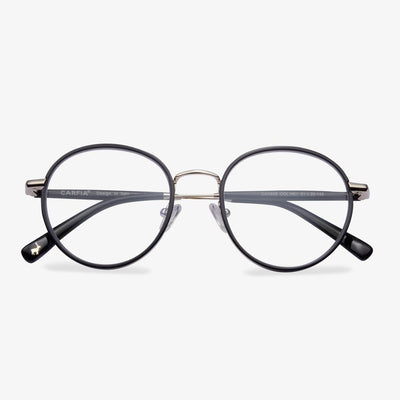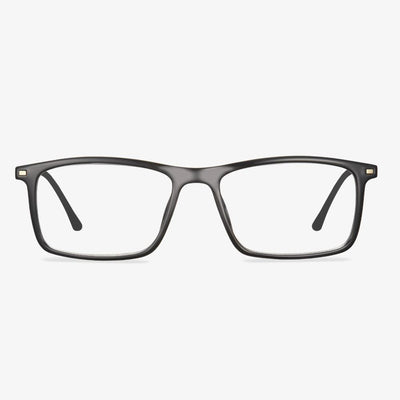Do prism glasses have side effects?
Prism glasses do not have side effects. Prescription prism glasses are designed to help your vision. Prism glasses are not apparently different from general glasses in terms of thickness. It may take a few days to get used to wearing new prism glasses or newer prescription glasses. There may be some eye strain during this time.
Progressive Lens
Standard progressive lenses are multifocal lenses with three observation areas, farsightedness, intermediate vision, and nearsightedness. Unlike bifocals, there are no visible lines between each viewing area. They have a seamless, invisible design, where the optical power changes 'gradually' throughout the lens. Many people confuse 'bifocal' or 'trifocal' with 'progressive' but remember that bifocals and trifocals have visible lines in the lens, while progressive lenses do not. Because progressive lenses have no lines in the lens, they are more popular multifocal lenses than bifocal lenses.
The main observation area of the progressive lens is a far distance, the smaller area at the bottom of the lens is used for myopia, and the middle area in the middle is smaller. Standard progressive glasses are very suitable for general purpose glasses, focusing on hyperopia activities (such as driving and walking) and sufficient area in the lenses for nearsighted activities (such as reading and computer use). The left and right sides or 'convex corners' of the lens are deliberately blurred to achieve an invisible design. The clearest line of sight in the gradual process is from the center to the top of the lens.
What is the best lens material?
MR stands for Mitsui Resin, a raw material for optical lenses made by Mitsui Chemicals in Japan. It is the first high refractive index lens material produced by polyurethane technology in the world. It has the characteristics of high refractive index, high Abbe number, low specific gravity, high impact resistance, and so on. MR series material, with high impact resistance, good tensile strength, and minimal internal stress, is very suitable for the unique design of lens products, like rimless glasses and high bending lenses, etc. At the same time, it has good processing, dyeing, and weather resistance.
Who should wear blue light glasses?
Teenagers, middle-aged and old people need to wear blue light glasses. The lens of a teenager is clear, pure, and still developing. Their eyes are less resistant to blue light than adults and are more vulnerable to long-term exposure to blue light, which can promote the development of myopia. Teenagers study more nervous, are free to love to play computer games, love to watch TV programs. Blue light damage can be said to be everywhere. As a result, teenagers are among the biggest victims of blue light. Macular degeneration is a common disease in the elderly, usually occurring after the age of 45, and the incidence increases with age. Blue light can accelerate the progression of macular degeneration, especially in patients following cataract surgery. Blue-blocking glasses are still the best preventative measure.
What Are Computer Glasses?
Computer glasses or glasses for computer are prescription glasses that are designed to wear when doing computer work. They allow you to focus your eyes on a computer screen. There are other activities such as playing piano or shooting requiring a similar custom fitting.
Glasses for computer use are also known as blue light glasses. They block blue light that causes eye strain due to prolonged viewing of digital screens. Blue light is part of the color spectrum, and everyone is exposed to it through sunlight.
The glasses for computer use have a shorter wavelength than other colors and are emitted by electronic devices such as smartphones, TVs, computers and more. The glare from blue light is what causes digital eye strain or other symptoms. But the glasses for computer can protect your eyes from the damage of the glare.
Depending on an individual’s vision and type of work, there are several options while selecting glasses for computer use.
Monofocal: Monofocal or single-vision glasses are designed for computer work so that they provide the appropriate optical correction for the working distance between the screen and the user’s eye. These glasses allow users to view the whole screen with a minimum up-and-down head movement. However, the disadvantage of the monofocal glasses is that both distant objects and reading materials that are closer than the computer screen will appear blurry.
Bifocal: When it comes to glasses for computer screens, the bifocal glasses would be a choice. Bifocal glasses can be prescribed so that the upper segment is set up for screen distance and the lower segment for work. The disadvantage of these bifocal glasses is that it will blurry if the objects are farther away than the screen.
Trifocal: These trifocal glasses for computers have lenses that combine a segment for far vision, another for near vision and the third one for at the screen distance. The disadvantage of these glasses for computer screen is the limitation to view areas.
Ray-ban clear frames are of high quality.
Ray-ban is one of the world's top ten brands of sunglasses, in addition to anti-UV400 ultraviolet lens, and filter out all kinds of harmful glare, the style of the glasses design highlights the temperament of the military, with the mature style of fashion and nobility. Ray-Ban's frame is the most part of Ray-Ban glasses, with unique design, atmosphere, and fashion, suitable for different situations and loved by many fashion people.
Select qualified optical lenses.
Anti-blue light lens must be qualified optical lens first and must have a certain percentage of anti-blue light effect. The general anti-blue light optical lens effect is about 30%. Even if it is not nearsighted people, it is best to choose the brand lens of reliable optical lens production enterprises. Anti-blue light lens is only suitable for people who use electronic display devices such as computers for a long time and is not suitable for patients with visual fatigue symptoms.











































